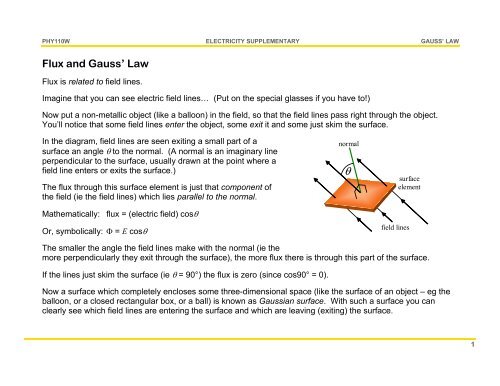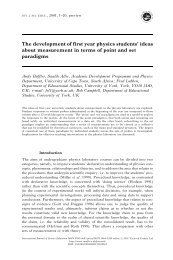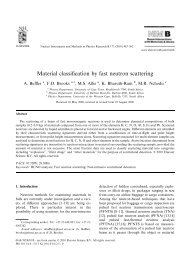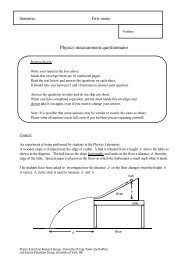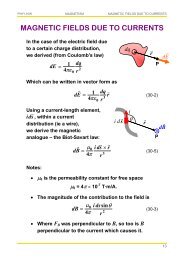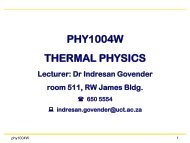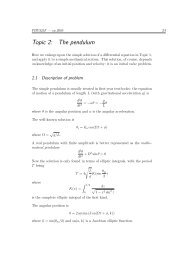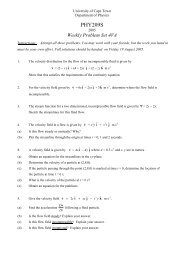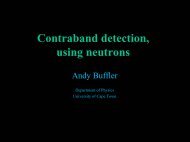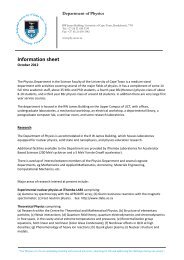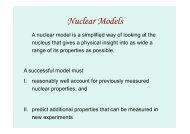Flux and Gauss' Law
Flux and Gauss' Law
Flux and Gauss' Law
You also want an ePaper? Increase the reach of your titles
YUMPU automatically turns print PDFs into web optimized ePapers that Google loves.
PHY110W ELECTRICITY SUPPLEMENTARY GAUSS’ LAW<br />
<strong>Flux</strong> <strong>and</strong> Gauss’ <strong>Law</strong><br />
<strong>Flux</strong> is related to field lines.<br />
Imagine that you can see electric field lines… (Put on the special glasses if you have to!)<br />
Now put a non-metallic object (like a balloon) in the field, so that the field lines pass right through the object.<br />
You’ll notice that some field lines enter the object, some exit it <strong>and</strong> some just skim the surface.<br />
In the diagram, field lines are seen exiting a small part of a<br />
surface an angle θ to the normal. (A normal is an imaginary line<br />
perpendicular to the surface, usually drawn at the point where a<br />
field line enters or exits the surface.)<br />
The flux through this surface element is just that component of<br />
the field (ie the field lines) which lies parallel to the normal.<br />
Mathematically: flux = (electric field) cosθ<br />
Or, symbolically: Φ = E cosθ<br />
normal<br />
θ<br />
surface<br />
element<br />
field lines<br />
The smaller the angle the field lines make with the normal (ie the<br />
more perpendicularly they exit through the surface), the more flux there is through this part of the surface.<br />
If the lines just skim the surface (ie θ = 90°) the flux is zero (since cos90° = 0).<br />
Now a surface which completely encloses some three-dimensional space (like the surface of an object – eg the<br />
balloon, or a closed rectangular box, or a ball) is known as Gaussian surface. With such a surface you can<br />
clearly see which field lines are entering the surface <strong>and</strong> which are leaving (exiting) the surface.<br />
1
PHY110W ELECTRICITY SUPPLEMENTARY GAUSS’ LAW<br />
We make things mathematically simpler (!) by turning the normal into<br />
the elemental area vector, dA , whose magnitude is equal to the area<br />
of the surface element, <strong>and</strong> whose direction is always out of the<br />
surface (at right angles to it, like the normal).<br />
So field lines which enter the Gaussian surface (for which θ is larger<br />
than 90°) result in negative flux (because cosθ is now negative).<br />
And, representing the field by the electric field vector, E , we can now<br />
write the equation even more simply (!) as:<br />
<br />
Φ = E ⋅dA<br />
area vector,<br />
<br />
dA<br />
θ<br />
electric field<br />
vector, E<br />
To find the flux through a whole area, we must sum the flux through each of<br />
the elements which makes up that area, or (as the size of each element → 0)<br />
integrate over the whole area:<br />
<br />
total Φ = ∫ E ⋅dA<br />
<br />
If the whole area is a complete Gaussian surface, we write: Φ = ∫ E ⋅dA<br />
,<br />
where Φ now represents the net flux through the Gaussian surface.<br />
The importance of this equation is that Gauss’ <strong>Law</strong> tells us that the net flux through a Gaussian surface is<br />
proportional to the charge enclosed by that surface, or mathematically: ε<br />
0Φ = qenclosed<br />
. Which gives us…<br />
Gauss’ <strong>Law</strong>:<br />
<br />
ε E⋅ dA=<br />
q<br />
∫<br />
0 enclosed<br />
…<strong>and</strong> from this we derive useful equations for the electric field due to various charge distributions.<br />
2
PHY110W ELECTRICITY SUPPLEMENTARY GAUSS’ LAW<br />
Types of questions<br />
Questions on this section usually fall into one of three categories:<br />
1. Calculating the flux through some given surface (maybe part of a bigger, complete, Gaussian surface).<br />
[This type of question is a bit artificial <strong>and</strong> is really just for practice.]<br />
2. Working with the net flux through an entire Gaussian surface <strong>and</strong> applying Gauss’ <strong>Law</strong> to find the<br />
enclosed charge (or vice versa).<br />
3. Using the principle of Gauss’ <strong>Law</strong> to determine the electric field due to some distribution of charge.<br />
[Which is the main purpose of this section – determining electric fields – so that we can easily determine<br />
the force on a charged particle, <strong>and</strong> from here the amount of work done in moving it, etc etc.]<br />
Examples:<br />
* * * * *<br />
Type 1. A cubic Gaussian surface is bounded by the planes at x = 0.40 m,<br />
y = 0.60 m <strong>and</strong> z = 0.40 m as shown in the sketch. The electric field in this<br />
region is non-uniform <strong>and</strong> is given by E = (2.00 + 3.00x 2 )î N/C. Calculate<br />
the flux through the right h<strong>and</strong> face (ie the shaded face) of the cube.<br />
<br />
Solution: Φ= ∫ E ⋅dA<br />
Over the whole shaded surface x = 0.40 m, so the electric field is a<br />
constant (2.00 + 3.00 × 0.40 2 ) = 2.48 N/C <strong>and</strong> lies in the positive x<br />
direction, ie parallel to the area vector, so cosθ = 1, <strong>and</strong> we get<br />
0.6<br />
0.2<br />
y<br />
z 0.4<br />
0.4<br />
Φ<br />
right<br />
= E∫ dA = E A = 2.48 × 0.40 2 = 0,397 N⋅m 2 /C<br />
[Strictly speaking, you should evaluate the dot product more formally using unit vectors.]<br />
x<br />
3
PHY110W ELECTRICITY SUPPLEMENTARY GAUSS’ LAW<br />
Type 2. A cubic Gaussian surface is bounded by the planes at x = 0.40 m,<br />
y = 0.60 m <strong>and</strong> z = 0.40 m as shown in the sketch. The electric field in this<br />
region is non-uniform <strong>and</strong> is given by E = (2.00 + 3.00x 2 )î N/C. Calculate:<br />
0.6<br />
y<br />
(a)<br />
the flux through each face of the cube;<br />
0.2<br />
(b) the net charge enclosed by the cube.<br />
<br />
Solution: (a) This time we must apply Φ = E ⋅dA<br />
over each of the six faces –<br />
∫<br />
z 0.4<br />
0.4<br />
which is actually not as much work as it seems, because the field has no components in the y<br />
or z directions, so there will be no flux through the top, bottom, front <strong>and</strong> back faces:<br />
Ie Φ top = Φ bottom = Φ front = Φ back = 0 N⋅m 2 /C<br />
We’ve already calculated the flux through the right h<strong>and</strong> face (in Type 1), so we only have to<br />
follow the same procedure for the left face, where x = 0 m.<br />
Here the electric field is a constant (2.00 + 3.00 × 0 2 ) = 2.00 N/C <strong>and</strong> again lies in the positive<br />
x direction. This time, however, the area vector points in the negative x direction (because it<br />
always points out of the Gaussian surface), so cosθ = –1, <strong>and</strong> we get<br />
Φ<br />
left<br />
= E∫ dA =−E A = –2.0 × 0.40 2 = –0,32 N⋅m 2 /C<br />
(b) Using Gauss’ <strong>Law</strong>, qenclosed<br />
= ε<br />
0Φ (where Φ is the total flux through all six faces)…<br />
∴q enclosed = 8.85 × 10 -12 × (0 + 0 + 0 + 0 + 0.397 + (–0.32)) = +6.80 × 10 -13 C<br />
x<br />
4
PHY110W ELECTRICITY SUPPLEMENTARY GAUSS’ LAW<br />
Type 3.<br />
The diagram shows, in cross section, a central metal ball, two<br />
spherical metal shells, <strong>and</strong> three spherical Gaussian surfaces of<br />
radii R, 2R <strong>and</strong> 3R, all with the same centre. The charges on the<br />
three objects are: ball, Q; smaller shell, 3Q; larger shell, 5Q.<br />
Show that the magnitude of the electric field at any point on any<br />
one of the surfaces is the same as at any other point on any of<br />
the surfaces.<br />
Shell<br />
R<br />
3R<br />
2R<br />
Gaussian<br />
surface<br />
Solution:<br />
There is no reference to first principles here, so we can simply use the equation for the electric<br />
field due to an enclosed point charge [which was derived earlier (p 17 of Lecture Notes) by<br />
<br />
applying Gauss’ <strong>Law</strong> (in the form ε<br />
0<br />
E⋅ dA = q ) to a point charged surrounded by a<br />
∫<br />
concentric Gaussian sphere of radius r]:<br />
E =<br />
enclosed<br />
q<br />
4πε<br />
r<br />
Q<br />
For the innermost Gaussian surface, r = R, <strong>and</strong> q (ie enclosed q) = Q, so E =<br />
2<br />
4πε<br />
R<br />
0<br />
2<br />
0<br />
For the next Gaussian surface, r = 2R, <strong>and</strong> the net enclosed charge is q = (Q + 3 Q), so<br />
4Q<br />
Q<br />
E = 2 2<br />
4 πε (2 R) = 4πε<br />
R<br />
, ie the same value as for points on the innermost surface.<br />
0 0<br />
And so on. (You should be able to finish it on your own now…)<br />
5


